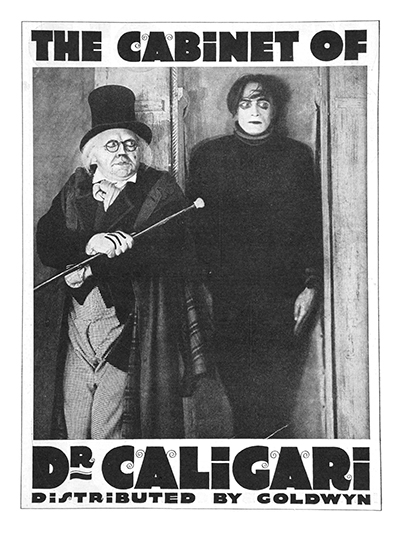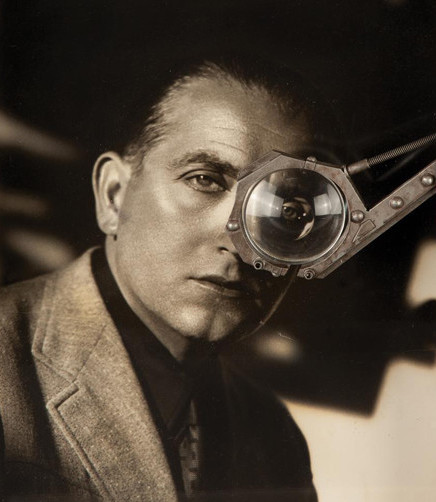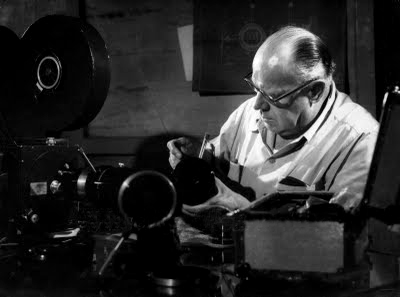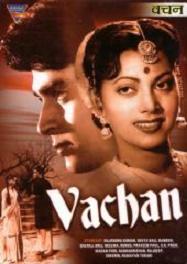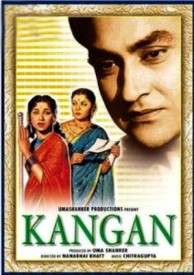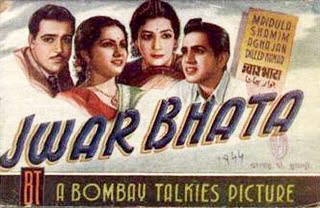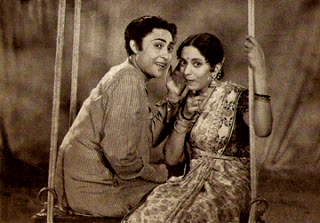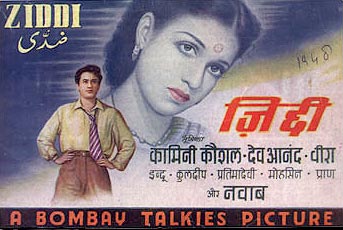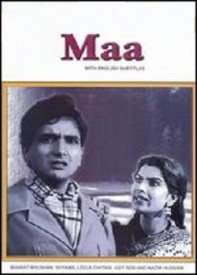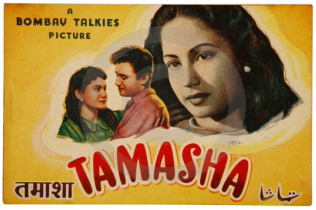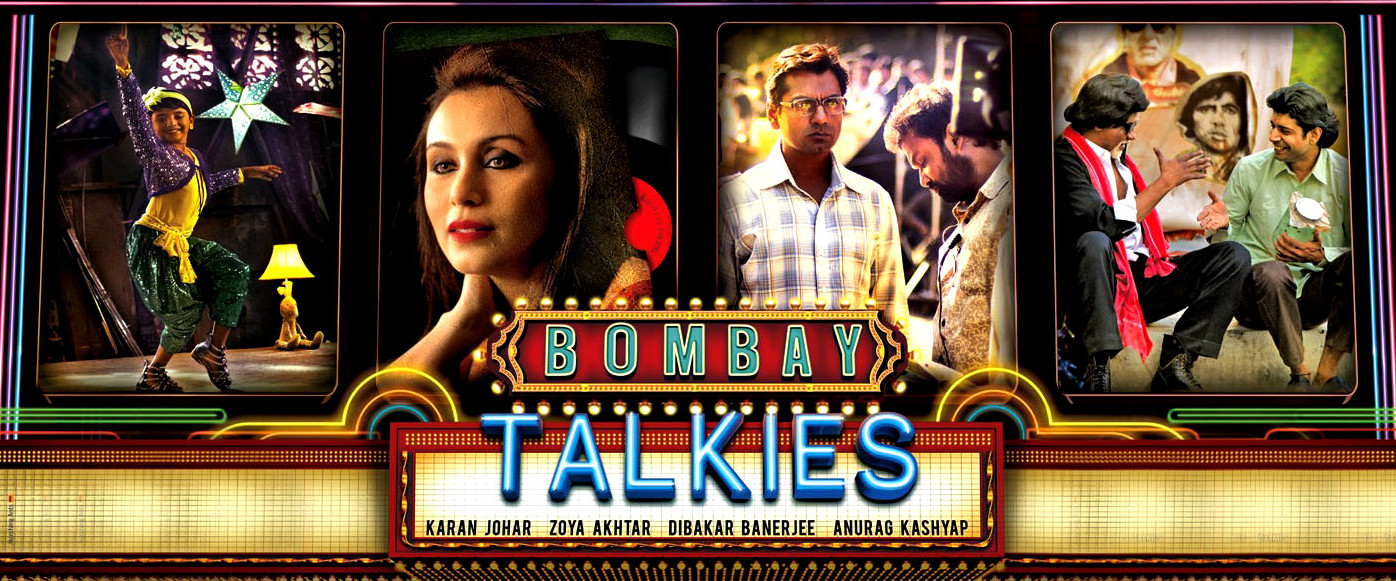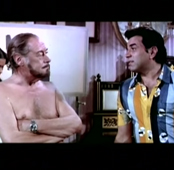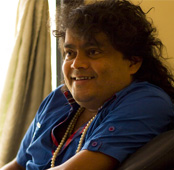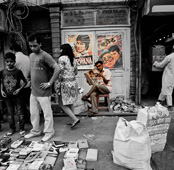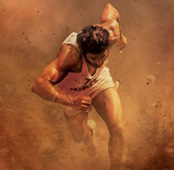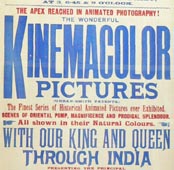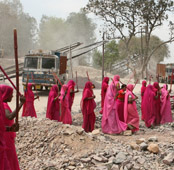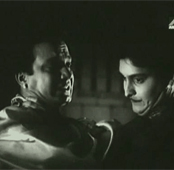-
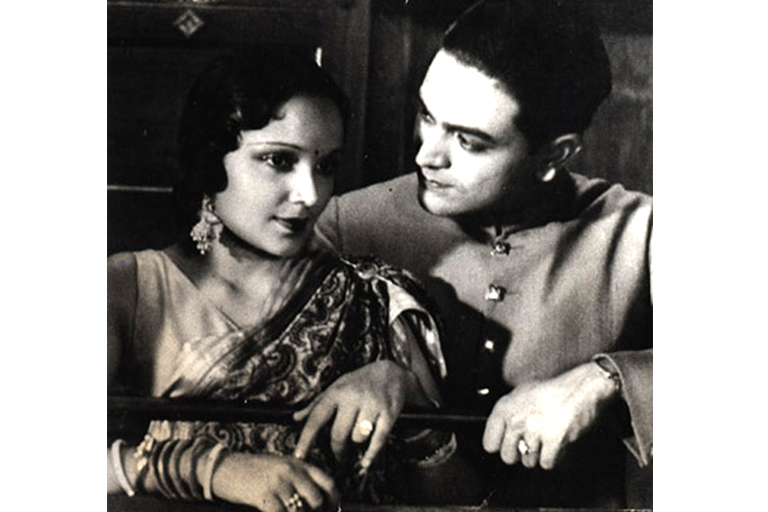 Devika Rani and Himanshu Rai during the Golden Era of Bombay Talkies
Devika Rani and Himanshu Rai during the Golden Era of Bombay Talkies -
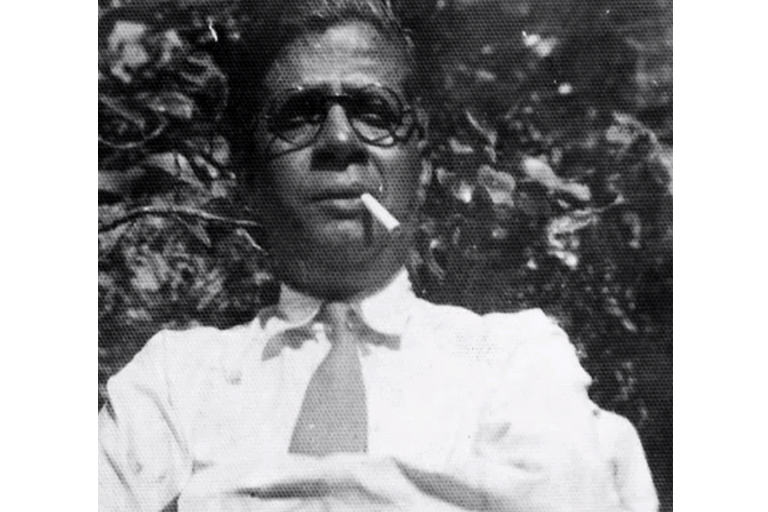 Niranjan Pal
Niranjan Pal -
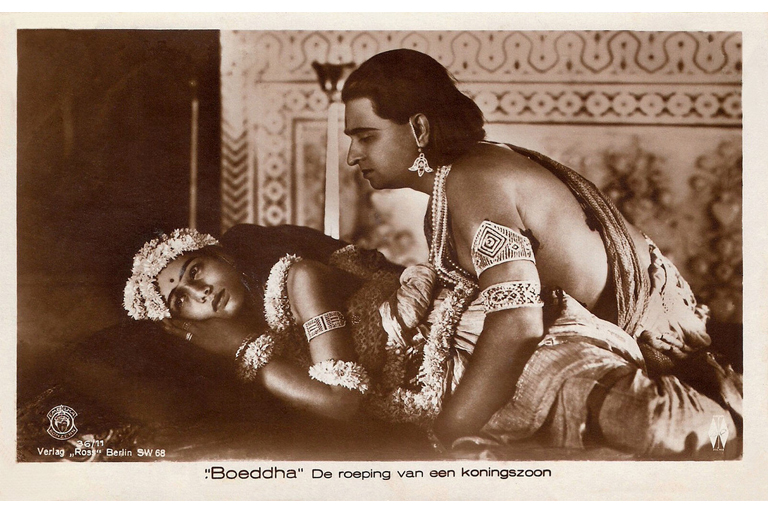 A still from The Light Of Asia/ Prem Sanyas
A still from The Light Of Asia/ Prem Sanyas -
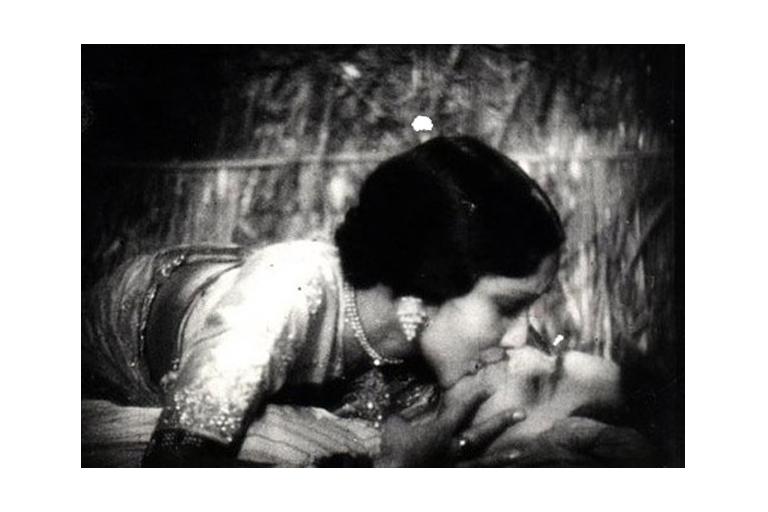 A still from Karma
A still from Karma -
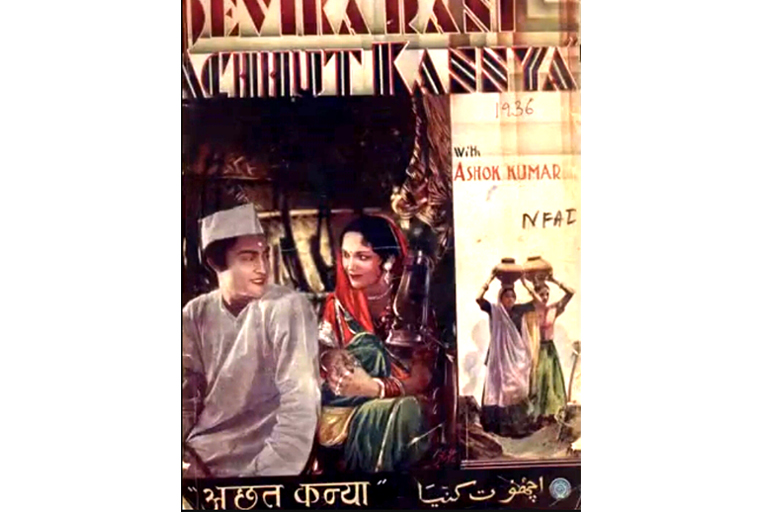 Poster of Achhut Kanya
Poster of Achhut Kanya -
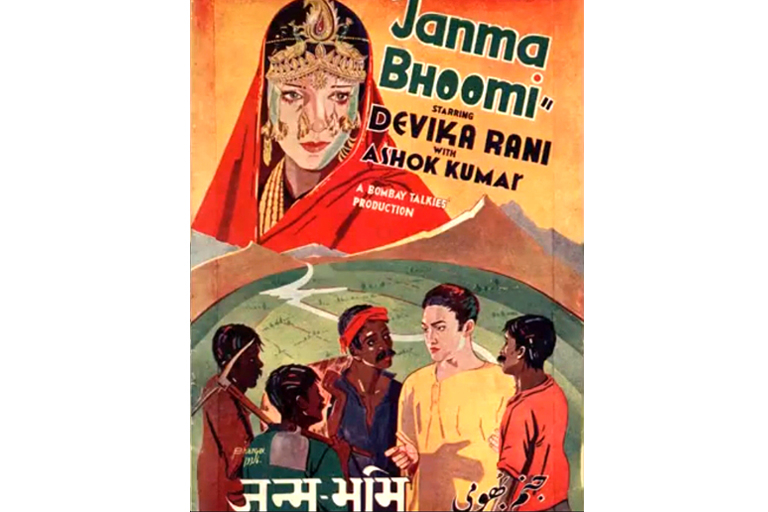 Poster of Janam Bhoomi
Poster of Janam Bhoomi -
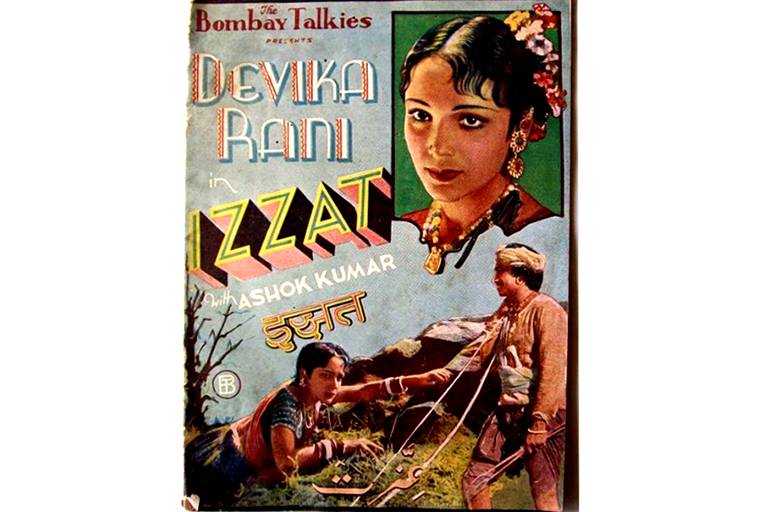 Poster of Izzat
Poster of Izzat -
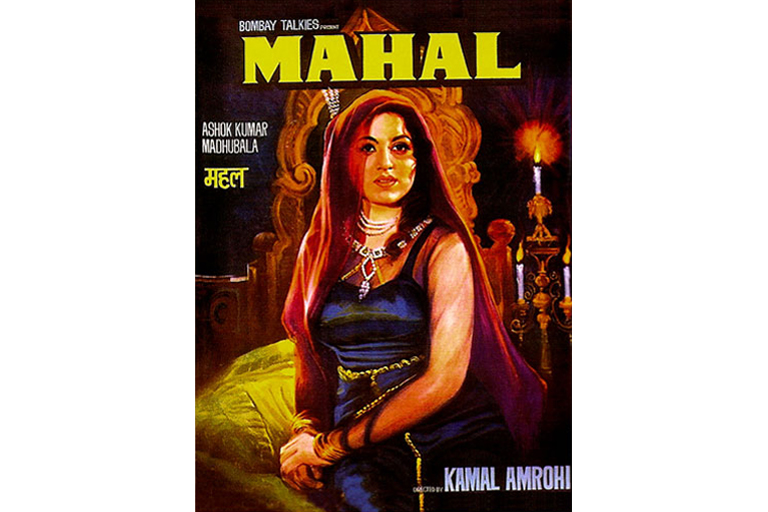 Poster of Mahal
Poster of Mahal -
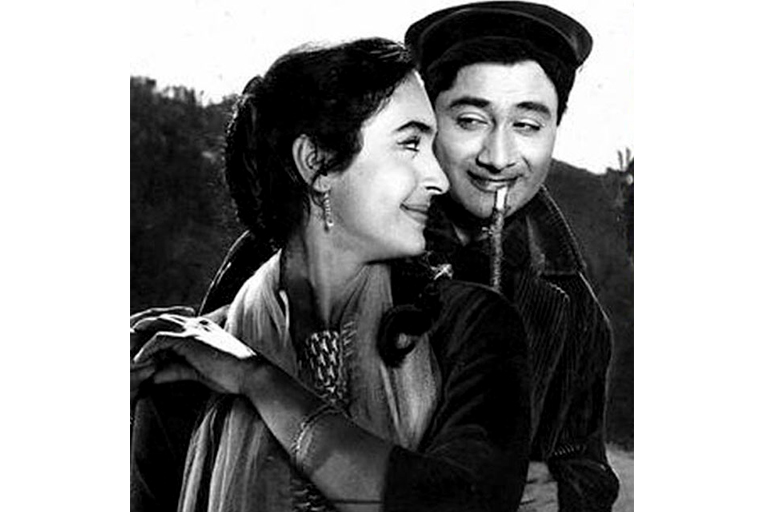 A still from Hum Ek Hain
A still from Hum Ek Hain -
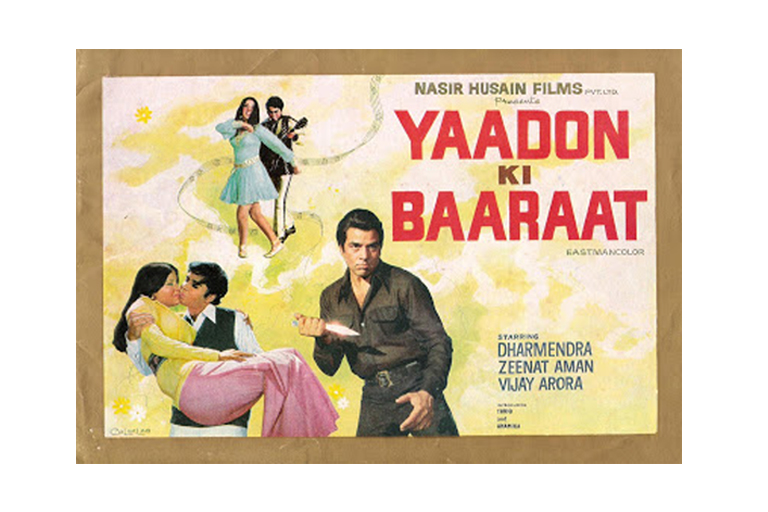 Poster for Yaadon Ki Baaraat
Poster for Yaadon Ki Baaraat -
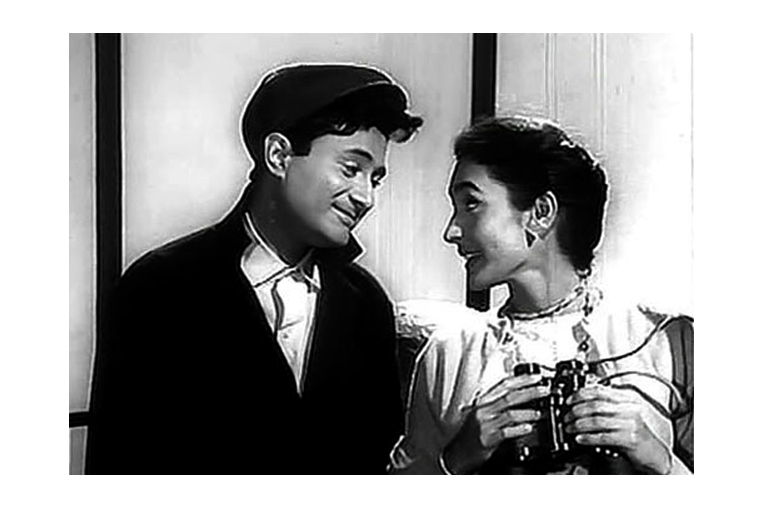 A still from Paying Guest
A still from Paying Guest
The story of Bombay Talkies that spawned India’s first ‘star’ Ashok Kumar and film families that hold sway over the industry till this date.
Khandwa, early 1930s
Kumudlal Ganguly was a misfit, a square peg in a round hole. Born in a family where every male member was either a practicing lawyer or harbouring dreams of becoming one, he was not really interested in the trade. At the insistence of his father, Kumudlal went to Calcutta to study law at the city’s prestigious Presidency College. Once there, he went straight to the principal of the college and, with the straight-shooting demeanour that would remain with him all his life, told him that he didn’t find the prospect of the legal profession very alluring, but wanted to become a director of films instead. The principal, a Mr. Ramanand Chatterjee, advised Kumudlal to attend the morning classes between 7 to 8 am, which would allow him the rest of the day to indulge his fantasies.
Kumudlal’s sister Sati Devi was married to Sashadhar Mukherjee, an M.Sc graduate who had moved to Bombay in search of work, and had begun work as a sound designer in films. When he heard of Kumudlal’s interest in cinema, Sashadhar called his young brother-in-law to Bombay. Kumudlal was then introduced to Himanshu Rai, the founder of Bombay Talkies.
***
Bombay Talkies was India’s first ‘corporatized’ film company, the first film company to be listed on the Bombay Stock Exchange (BSE). Also, the launching pad for most of Hindi cinema’s biggest stars. The company firmly established Mumbai (then Bombay) as the nerve-centre of the Hindi film industry. But the events that led to its inception were set in motion across Calcutta, England, and Germany.
Though things really began in London, sometime in the 1920s.
In the beginning there was the trinity.
There are three people who are responsible, primarily, for the birth of Bombay Talkies. The first is Himanshu Rai who was born in an illustrious Bengali family in 1892. After graduating from Calcutta University, Rai was shipped off to England to practice law. Once in London, he became a participant in the theatre scene and worked in Chu Chin Chow, Oscar Asche’s landmark musical.
The second is Niranjan Pal who was the progeny of Bipin Chandra Pal— a renowned nationalist and one of the famous trio of freedom fighters colloquially referred to as ‘Lal-Bal-Pal’ (besides Pal, the trio comprised Lala Lajpat Rai and Bal Gangadhar Tilak). Niranjan, like his father, was a radical from the word go. Bubbling with nationalist fervour, he was known to have once jumped a Scotsman and made off with his gun. It was to evade the consequences of this that Pal was sent to London. Soon, he found himself writing for the stage, and attained much success with plays such as The Goddess.
The third name is that of Devika Rani, the original diva of Hindi Cinema. Rani was a grandniece of the great poet and polymath Rabindranath Tagore. Born in 1908 at Waltair (now Visakhapatnam, in Andhra Pradesh) to Col. M. N. Choudheri, Devika Rani Choudheri travelled to England for higher education, a norm among the Indian intelligentsia at the time. At the tender age of 16, she was awarded scholarships at the Royal Academy of Dramatic Arts and the Royal Academy of Music, both in London.
***
Niranjan Pal continued his winning streak with a number of plays at London’s West End. The stage brought him in contact with Himanshu Rai, who was already toying with the idea of making films. They decided to collaborate on an adaptation of Sir Edwin Arnold’s epic poem ‘The Light of Asia’. It was the 1920s. German cinema was making great strides, with expressionist films like The Cabinet of Dr. Caligari and Nosferatu breaking new ground. Rai arrived in Munich to scout filmmakers at the Emelka Film Company. The 48 year-old Franz Osten came forward. In what was to be a historic decision, Franz Osten not only helmed The Light of Asia/ Prem Sanyas (1925), but ended up directing more than a dozen Indian films over the next fifteen years. Rai himself played the lead in Prem Sanyas, as Prince Siddhartha, or Gautama Buddha. Pal wrote out the scenes for the film.
How Devika Rani came to meet Himanshu Rai is an unresolved mystery. Some say they met a few years after Prem Sanyas while others believe they not only met earlier, but it was actually Devika who designed costumes for Prem Sanyas. By the time she was 20, she had already been in touch with Marlene Dietrich, assisted the great Fritz Lang, and begun professional work in textile design. By some accounts, Devika was staying as a house-guest of Niranjan Pal and his family.Legend has it that Rai was introduced to her at a party. One may imagine that Rai would have been taken in by Devika Rani’s enormous reservoir of talent, as much as by her beauty. He offered her a job designing costumes for his films.
In three years, there was a forgettable film called Shiraz (1928), followed by the classic A Throw of Dice/ Prapancha Pash (1929). The latter, a lavishly mounted Mahabharata re-telling, remains one of the few by Osten and Rai that survives in its entirety, and has seen a revival on the film festival circuit in the past few years. By the time the film was complete, Rai and Devika got married— a relationship that was to be inordinately tumultuous in the years to come.
With the advent of the ‘talkies’, or the sound films, the movie business in Germany was in a state of flux. Rai returned to London, his young bride in tow. In 1933, the duo co-starred in Karma, a bilingual— their first talkie. Today the film is mostly remembered for a passionate kiss they shared on-screen. But back then this first Indian talkie to have English dialogues was met with great excitement by the British press. Leading periodicals of the time acknowledged Devika Rani’s star aura and grace, and praised her impeccable accent. The London Star said: “You will never hear a lovelier voice or diction, or see a lovelier face.”
By now, both of them had acquired a rich and varied experience in filmmaking. Soon they set sail for India. Whenever Rai had come to India, the state of the film trade in the country had disconcerted him. He longed to implement what he had learnt in Britain and Germany, and set up a major studio that would churn out film after glorious film, making India a force to reckon with in the international arena. In 1934, Bombay Talkies was born.
Parsi businessman Sir F. E. Dinshaw’s summer mansion in Malad was transformed into a studio for this purpose. Bombay Talkies was incorporated as a public limited company and listed on the BSE. On its board, Himanshu Rai assembled the crème de la crème of Bombay’s business class then: besides Dinshaw, there was Sir Chunilal Mehta, Sir Chimanlal Setalvad, Sir Phiroze Sethna, Sir Cowasjee Jehangir and Sir Richard Temple. Rajnarayan Dube, the construction magnate, emerged as the chief financier and, in time, the truest mentor of Bombay Talkies. The German director Franz Osten and his team of technicians—cinematographer Josef Wirsching, set designer Karl Von Spreti, sound recordist Len Hartley, lab technician Wilhelm Zolle—joined in on this ambitious enterprise. In a way, Bombay Talkies laid the foundations for international collaboration in Hindi films— crossovers in the truest sense, long before the term came into being. The studio attracted talent in droves from every corner of India: Filmmakers like Najam Naqvi, N.R. Acharya, Sashadhar Mukherjee, M. I. Gharamse, Savak Wacha and R. D. Mathur, actors like Ramshakal Sarikhe, Kishore Sahu, Snehprabha Pradhan and Renuka Devi and writers like Saadat Hasan Manto and Khwaja Ahmed Abbas.
Star ‘Dom’
Let us return now to Kumudlal Ganguly. He joined Bombay Talkies as a technician. It was the early 1930s. He was busy learning the craft of filmmaking. Kumudlal apprenticed in almost every department— sound, editing, music, cinematography, and he was curious about everything. The veteran cinematographer Josef Wirsching, however, took great umbrage to Kumudlal tinkering with his camera. He insisted that he be moved to another department.
Bombay Talkies’ first major picture, Jawani Ki Hawa (1935) was a crime thriller featuring Devika Rani playing the lead opposite the young Najmul Hasan, who was debuting with that film. The film instigated furious protests by the Parsi community of Bombay, who objected to the inclusion of two Parsi women in the film (acting in the movies was looked down upon in those times, and so the community wanted no part of it). But the din died down soon after, and the film did well.
After Jawani Ki Hawa, another movie called Jeevan Naiya with the same lead pair was being shot, when a curious incident occurred, that was to seal the fate of Bombay Talkies, and lead to far-reaching changes in the Indian film industry.
During the shoot Devika Rani eloped with Najmul Hasan. All hell broke loose at Bombay Talkies. The future of the film, and Himanshu Rai’s marriage, was at stake. Sashadhar Mukherjee, disturbed at his mentor’s predicament, swung into action. He convinced Devika Rani to return, sans Najmul. How he managed to do this, what he said to her, remains unknown till this date. Though he forgave his wife, Rai was livid at Hasan, expectedly, and resolved to never work with him again. So, at the end of it all, they were left without a lead actor for the film.
Kumudlal, still in his 20s then, had a great singing voice, besides good looks. Mukherjee suggested him as a replacement. Kumudlal was reluctant to act initially, but he agreed to give it a try just once, and then get back to his job as a technician. A hurried screen test was done. Josef Wirsching was happy with the outcome though director Franz Osten wasn’t. But Rai persisted, and soon Kumudlal was the hero of Jeevan Naiya.
But there was another problem. With a name like ‘Kumudlal Ganguly’ for the lead the film’s prospects at the box office would be abysmally low. A screen-name was sought. Kumudlal Ganguly was rechristened with the name that we know him by. Jeevan Naiya, starring ‘Ashok Kumar’, was released in 1936 and India’s first real star, a man who can be said to have paved the way for the emergence of the ‘star system’ in Hindi cinema, was born.
Ashok Kumar’s first truly successful film, Achhut Kanya (1936), was made and released in the same year as Jeevan Naiya. The tale of a Brahmin boy (Kumar) falling for an ‘untouchable’ girl (Devika) was based on a short story by Niranjan Pal. The film was a runaway success and the song Main Ban Ki Chidiya, sung by Kumar himself, was on everyone’s lips. The lead pair of Ashok Kumar and Devika Rani went on to become a sure-fire formula for success. They featured in one film after another: Janam Bhoomi (1936), Izzat (1937), Prem Kahani (1937), Savitri (1937)… The reluctant hero became a sensation.
Ashok Kumar can be said to be the first true ‘star’ in Hindi films for many reasons. But the one that comes to mind first and foremost is that, realizing his marketability, he became the first actor in India who began to charge rates that were beyond the salaries offered by the studios. As acclaimed writer and close friend Saadat Hasan Manto (who also worked for Bombay Talkies) wrote in his literary sketch of Kumar, (published in an anthology of his writings called Stars from Another Sky):
When he moved from the laboratory to acting, his monthly salary was fixed at seventy-five rupees, a sum he accepted happily. In those days, for a single person living in a far-flung village, which Malad was, it was a lot of money. When his salary was doubled, he was even happier. Not long after, when it was raised to two hundred and fifty rupees, he was very nervous. Recalling that occasion, he said to me, “My God… it was a strange feeling. When I took the money from the studio cashier, my hand was trembling. I did not know where I was going to keep it. I had a place, a tiny house with one bed, two or three chairs, and the jungle outside. What would I do if thieves paid me a visit at night? What if they came to know that I had two hundred and fifty rupees? I felt lost… I have always been terrified of thefts and robberies, so I finally hid the money under my mattress. That night I had horrible dreams, so next morning I took the money to the post office and deposited it there.”
While Ashok was telling me this story, outside, a filmmaker from Calcutta was waiting to see him. The contract was ready but Ashok did not sign it because while he was offering eighty thousand rupees, Ashok was insisting on one lakh. And to think that only some years earlier he had been at a loss to know what to do with two hundred and fifty rupees!
House of Cards
In 1936, the year of Kumar’s acting debut, Niranjan Pal and Himanshu Rai had a major falling out. Pal had written some articles for a magazine named Filmland, which were scathing in their criticism of the use of foreign technicians in Indian films. Some of them specifically cited the example of Franz Osten. Rai was furious and forbade Pal from expressing such controversial opinions in print. Niranjan Pal walked out of Bombay Talkies, never to look back again.
Pal was replaced by Saradindu Bandyopadhyay, a Bengali writer famous for having created the fictional detective Byomkesh Bakshi (popularized nationally after he was played by Rajit Kapur on Doordarshan in a series directed by Basu Chatterjee in the 1990s). Within two years of Bandyopadhyay’s joining, three films were released by Bombay Talkies: Nirmala (1938), Vachan (1938) and Durga (1939). Vachan was the debut of comedian Rajendra Nath, whose portrayal of the character of ‘Popatlal’, later in the day, would become so famous that the name of the character would become synonymous with his own.
Meanwhile, Franz Osten had joined the Nazi Party and, with the onset of the Second World War, the Indian government came down heavily on Osten and his team. With their arrest several Bombay Talkies productions were interrupted. Some of them, like Kangan (1939), were completed in a hurry. But even most of these flopped miserably. Rai began to show symptoms of an impending mental breakdown. The situation worsened and finally he had to be admitted to a hospital. As Rai’s team met him at the hospital for his approval of a script, he grabbed the sheets of paper and garbled something unintelligibly. A few minutes after this Himanshu Rai—the founder of the most prolific studio Hindi cinema had ever seen—was dead. It was May 16, 1940.
Devika Rani stepped in as her husband’s successor. She divided Bombay Talkies into two production units, headed by Amiya Chakravarty and Sashadhar Mukherjee respectively. A young Raj Kapoor had joined as assistant to director Kidar Sharma and Amiya Chakravarty. Doubling up as the clapper-boy, even sweeping floors, Raj Kapoor learned filmmaking on the job. The fact that his father Prithviraj was a renowned actor of the era made little difference. During the making of Vish Kanya (1943), the future showman was busy fixing his hair in the mirror as he always did, before hammering the clap. But this time, the director Kidar Sharma was in a hurry as it was a sunset scene and it was almost dark. Raj took his own time and in a fit of rage, Sharma landed a resounding slap on the boy’s cheek. Sharma admittedly felt sorry later on, and perhaps this, as well as his talent and enthusiasm, had something to do with Kapoor’s first break as a hero with Neel Kamal, directed by Sharma, four years later.
Meanwhile, Yusuf Khan, Kapoor’s childhood friend from his early years in Peshawar, was making a living working at the Army Canteen in Pune. Devika Rani spotted him while on a trip to Pune, and enquired whether he’d like to act. Yusuf curtly refused. He had been made to believe that acting wasn’t an honourable profession. Devika Rani persisted. Finally, Yusuf relented and it was decided that he’d star in Jwar Bhata (1944), to be directed by Amiya Chakravarty. Eminent novelist and screenwriter Bhagwati Charan Verma decided on a screen name for him— ‘Dilip Kumar’.
They came, they saw, they glittered.
Ashok Kumar had garnered unprecedented popularity with hits like Bandhan (1940), Jhoola (1941) and Naya Sansar (1941). His pairing with Leela Chitnis or Devika Rani always worked. But Kismet (1943), directed by Gyan Mukherjee, was the film that consolidated Ashok Kumar’s position as the most valued star of the era. It ran for three years, a record unbroken for thirty years, till Sholay arrived on the scene.
During this time, a major rift emerged at Bombay Talkies, between Devika Rani on one side and Sashadhar Mukherjee and Ashok Kumar on the other. Mukherjee, Kumar and some other key personnel quit Bombay Talkies and laid the foundation for a new studio. They named it ‘Filmistan’. With their departure, Bombay Talkies plunged into darkness. Films of this period from Bombay Talkies, such as Char Ankhen (1944), Jwar Bhata and Pratima (1945), were all expensive flops. The proverbial last nail in the coffin was dealt by Devika Rani herself, who chose to turn her back to the movies by marrying Svetoslav Roerich, an acclaimed Russian painter, and settling down amidst the idylls of Himachal (they later moved to a sprawling estate on the outskirts of Bangalore). Bombay Talkies, much like a tattered currency note, changed hands a number of times during the next three years. Ashok Kumar, producer Savak Vacha and cinematographer Josef Wirsching each returned to their home turf and, during these brief periods, Bombay Talkies witnessed flashes of its lost glory: Milan (1946), Nateeja (1947), Majboor (1948) and Ziddi (1948).
The casting of Ziddi’s protagonist makes for an interesting story. During an elaborate meeting on the film’s casting, Ashok Kumar stepped outside for a smoke and noticed a youngster waiting, distress wrought on his face. When he enquired, the boy said that his name was Dharam Dev Pishorimal Anand, and that he wanted to become an actor. His first film Hum Ek Hain (1946) had tanked, and he was hoping for a better launch with Bombay Talkies. Kumar decided on the young man as Ziddi’s hero, despite objections by other members of his team. The film went on to be a huge hit, and two new stars were born: Dev Anand and Kishore Kumar, who had debuted in playback singing with Ziddi.
Another playback singer was waiting in the wings at the time. A young Lata Mangeshkar was chosen by Ashok Kumar to sing for Mahal (1949), a thriller directed by Kamal Amrohi. India’s first gothic horror film, Mahal became an overnight phenomenon, and made stars of two young women: Lata Mangeshkar (her song Aayega Aanewaala is still as popular as it was over half a century ago), and Madhubala, the leading lady. Ashok Kumar’s next film Sangram (1950) helmed by Gyan Mukherjee, featured the actor in his most striking negative role, and launched the actress Nalini Jaywant.
Then, Ashok Kumar and his entourage left Bombay Talkies for a second time. This dealt a severe blow, one the studio never quite recovered from. The next few films from the company—Mashaal (1950), Maa (1952) and Tamasha (1952)—sank without a trace. In those gloomy days, another filmmaker, who was to become a giant of Indian cinema, had been brought in to save the ship. Bimal Roy had only directed Bengali films till then, and he visited Bombay with the intent of doing just one film, Maa, and returning to Calcutta. He stayed back, however, and created history later with Do Bigha Zameen (1953), but his initial films for Bombay Talkies didn’t work. Some of the stars came forward to work for free for the studio, as their tribute to an institution that had launched them. But it was time to draw the curtains. In 1954, two decades since its inception, Bombay Talkies shut down for good.
Mumbai, 2013
In the following years, Ashok Kumar scaled new heights of popularity, and later moved on to character roles. Raj Kapoor, Dilip Kumar and Dev Anand went on to become the first big ‘star-triumvirate’ of Hindi cinema in the 1950s. Filmistan produced many a successful film and bred talents like Nasir Hussain— who went on to be a successful producer himself, and happened to have a nephew named Aamir Khan. One of his films, Yaadon Ki Baarat (1973), in which he cast this nephew as a child actor, was written by two young writers called Salim Khan and Javed Akhtar. Salim’s most lasting contribution to Hindi cinema, other than the legendary scripts he wrote, is in the form of his son, Salman Khan who, along with Aamir and Shah Rukh, makes up the big star-triumvirate of today.
Sashadhar Mukherjee, after a glorious career producing gems like Munimji (1955), Tumsa Nahi Dekha (1957) and Paying Guest (1957), and setting up his own production house called Filmalaya, also became the patriarch of an illustrious film family of stalwarts, such as filmmakers Subodh and Shomu Mukherjee, actors Joy and Deb Mukherji and the actress Tanuja (Shomu’s wife). The next generation of the family has added one filmmaker—Ayan Mukerji, who directed Wake Up Sid and Yeh Jawaani Hai Deewani—and three actresses—Kajol, Sharbani and Rani Mukerji—to our cinemascape. Of them, Kajol and Rani Mukerji are the most well known. The latter’s last film was one of an anthology shot by some of today’s most acclaimed filmmakers. It was put together to commemorate a centenary of Indian cinema. It was named, appropriately, Bombay Talkies.
Birth of an Industry
ArticleOctober 2013
 By Amborish Roychoudhury
By Amborish Roychoudhury
Amborish Roychoudhury is a Social Media professional and film fanatic. He's also fond of comics and classic detective fiction. A Bengali who was exposed to a deluge of literature, music and cinema, with a liberal dose of Doordarshan from an early age, this queer mish-mash resulted in a keen awareness of pop-culture, particularly cinema.



